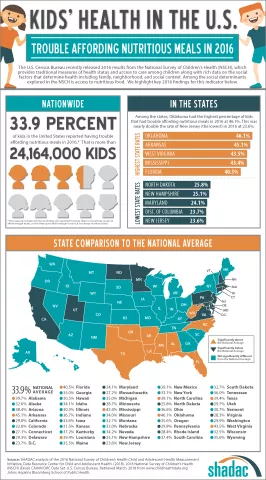
In the coming weeks, SHADAC is highlighting state-specific findings from the 2016 NCSH on measures that illustrate where states are closer to achieving a culture of health and where improvements can be made. As additional years of NCSH data are released, we will be able to monitor trends in these indicators to track progress in developing a culture of health over time.
According to 2016 data from the NSCH, 33.9% of children nationwide (approximately 24,164,000 children) had trouble affording nutritious meals in 2016.[1]
The five states with the highest percentages of children who had trouble affording nutritious meals in 2016 were Oklahoma (46.1%), Arkansas (45.1%), West Virginia (43.5%), Mississippi (43.4%), and Florida (40.5%).
The five states with the lowest percentages of children who had trouble affording nutritious meals in 2016 were New Jersey (23.6%), the District of Columbia (23.7%), Maryland (24.1%), New Hampshire (25.1%), and North Dakota (25.8%).
In all, the percentage of children that had trouble affording nutritious meals was statistically below the national average in 14 states and statistically above the national average in nine states.
Click on the infographic for additional state-level information about children’s access to nutritious meals.
Additional Kids’ Health Data Highlights
Kids' Health in the U.S.: Difficulties Making or Keeping Friends in 2016
Kids' Health in the U.S.: Parental Attendance at Kids' Activities in 2016
Kids'Health in the U.S.: Living in Neighborhoods with No Amenities in 2016
Kids’ Health in the U.S.: Living in Supportive Neighborhoods in 2016
Kids’ Health in the U.S.: Living in Working Poor Households in 2016
More about the NSCH
The NSCH was administered three times prior to 2016 – in 2003, 2007, and 2011/12. However, the 2016 NSCH is different because it integrated the NSCH with the National Survey of Children with Special Health Care Needs (NS-CSHCN) and introduced a number of new survey items, establishing a new baseline. Going forward, the NSCH will be administered annually. The survey is administered online and via mail, and survey results are weighted to represent the population of non-institutionalized children ages 0-17 who live in housing units nationally and in each state.
The full 2016 NSCH public-use file (PUF) is available on the Census Bureau’s NSCH page
[1] This estimate includes children in families who reported that they often or sometimes could not afford enough to eat or that they could afford enough to eat but not always nutritious food.

